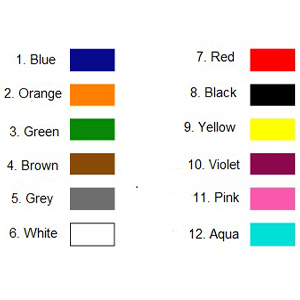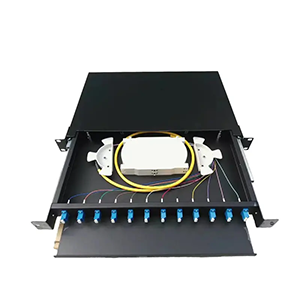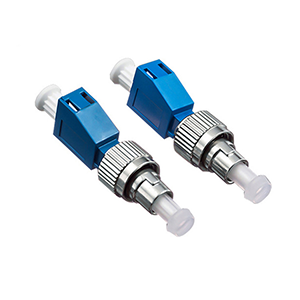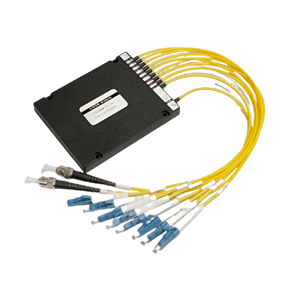Hello everyone! As an important standard in the construction and maintenance of optical fiber networks, the color coding of 12-core optical fibers has always been valued by us. It can not only simplify network cabling management, but also effectively meet the needs of simple application scenarios such as small computer rooms and buildings. Today I am honored to give you an in-depth introduction to the characteristics of this coding standard and its typical applications in different fields.
Overview of 12-Core Fiber Color Coding
Let me introduce to you an overview of 12-core fiber color coding, as well as its differences and applicable scenarios with 24-core coding:
Definition of 12-core optical fiber color coding standard:
- 12-core optical fiber color coding is a simplified version of the optical fiber core identification scheme.
- It stipulates the specific color combinations that 12 optical fiber cores should use, forming a basic coding system.
- This standard was developed by the optical fiber industry organization and aims to provide easier management solutions for small and medium-sized optical fiber networks.
The role of 12-core coding standards in simplifying fiber optic network cabling management:
- Provides a more intuitive and easy-to-understand way to identify optical fiber resources.
- Reduces the complexity of fiber identification and connection, and improves operation and maintenance efficiency.
- Suitable for small and medium-sized optical fiber networks to meet basic management needs.
- Provide a transitional path for subsequent upgrades to more complex coding systems.
The differences and applicable scenarios between 12-core encoding and 24-core encoding:
- Difference: 12-core encoding uses 12 basic colors, and 24 fiber color code has more extended colors. The 12-core encoding logic is simple, and the 24-core encoding has richer encoding levels. 12-core encoding is suitable for small scale, and 24-core encoding is suitable for large-scale optical fiber networks.
- Applicable scenarios: 12-core encoding is suitable for small and medium-sized optical fiber networks, such as buildings, small businesses, etc. 24-core encoding is suitable for large-scale optical networks, such as data centers, telecommunications trunk lines, etc. 12-core encoding can be used as a transitional solution for 24-core encoding, and management can be gradually upgraded.
So, 12-core optical fiber color coding is a simplified management solution for small and medium-sized optical fiber networks. It can effectively simplify the identification and maintenance of optical fiber resources and improve network operation and maintenance efficiency. The 24-core encoding is more suitable for the management needs of large-scale and complex optical networks. The two coding standards complement each other and jointly promote the standardization and intelligent development of optical fiber networks.
Details of color coding of 12-core optical fiber
Let me introduce to you in detail the specific content and application value of 12-core optical fiber color coding:
12-core optical fiber color coding corresponding color sequence:
- Core 1: Blue
- Core 2: Orange
- Core 3: Green
- No. 4 core wire: brown
- No. 5 core wire: gray
- No. 6 Core Wire: White
- No. 7 core wire: red
- No. 8 core wire: black
- No. 9 core wire: yellow
- No. 10 core wire: Purple
- No. 11 core wire: pink
- No. 12 core wire: turquoise
The fiber types or uses represented by each color:
- Blue, orange, green, and brown: represent single-mode optical fiber
- Gray and white: represent multi-mode optical fiber
- Red and black: represent optical fibers with special purposes, such as protection or reserved channels
- Other colors: used to distinguish different fiber channels
The application value of 12-core coding in optical fiber identification and classification:
- Simple and intuitive color marking improves the visibility of fiber optic cabling.
- By encoding logic, the type and purpose of the optical fiber can be quickly inferred.
- Suitable for small and medium-sized optical fiber networks to meet basic management needs.
- Provide a transition plan for subsequent upgrades to more complex coding systems.
- Lay the foundation for visual management and intelligent operation and maintenance of optical fiber networks.
In short, although the 12-core optical fiber color coding system is relatively simple, it still provides an important basis for the orderly deployment and efficient management of small and medium-sized optical fiber networks. Through the intuitive identification and coding logic of color, the recognizability and traceability of optical fiber resources are greatly improved, laying the foundation for promoting the intelligent development of optical fiber networks.
Application scenarios of 12-core optical fiber color coding
Let me introduce to you how 12-core optical fiber color coding is reflected in different optical fiber network application scenarios, and its advantages in meeting simple network requirements.
Application of 12-core coding in optical fiber networks in small computer rooms:
- Small computer rooms have relatively few fiber channels and have relatively simple management requirements.
- 12-core encoding can quickly meet the fiber identification needs of small computer rooms.
- Simple and intuitive color coding facilitates daily maintenance by computer room managers.
Application of 12-core coding in optical fiber cabling inside buildings:
- The optical fiber channels inside the building are relatively centralized, and the management requirements are not too complicated.
- 12-core coding can meet the basic identification requirements for building optical fiber cabling.
- Easy for building managers to quickly identify and manage fiber optic resources in the building.
Application of 12-core coding in FTTH (fiber to the home) network:
- The fiber channel of FTTH network is relatively simple and is mainly used by residential users.
- 12-core encoding can meet the basic management needs of FTTH networks.
- Simple and easy-to-understand coding logic is helpful for users to understand and maintain.
Advantages of 12-core encoding in meeting simple network requirements:
- The coding system is simple and clear, with low management cost and complexity.
- Suitable for small and medium-sized optical fiber networks to meet basic identification and management needs.
- Provides a transitional solution for upgrading small-scale networks to more complex coding systems.
- Lay the foundation for promoting visual and intelligent management of optical fiber networks.
In short, the 12-core optical fiber color coding system is more suitable for small and medium-sized optical fiber networks with relatively simple management requirements. It can quickly meet the basic management needs of such networks, reduce management costs and complexity, and provide a transitional path for subsequent upgrades to more intelligent coding systems. This flexible application feature makes it widely used in small computer rooms, buildings, FTTH and other scenarios.
Standard implementation of 12-core optical fiber color coding
Let me introduce to you in detail how to standardize the implementation of the 12-core optical fiber color coding standard and the key management strategies to ensure coding consistency:
Application in network design phase:
- When planning optical fiber resources, fully consider the requirements of the 12-core coding standard.
- Reserve enough coding space during design to ensure future scalability.
- Clear different types of optical fibers and their corresponding color coding schemes.
Application during installation and construction phase:
- In strict accordance with the requirements of coding standards, the optical fiber core wires are identified and marked.
- Make sure the color of the fiber optic connector matches the coding requirements to avoid incorrect wiring.
- Record the specific coding information of optical fiber cabling to facilitate subsequent maintenance and management.
Application in daily maintenance management:
- Regularly check the completeness and accuracy of fiber identification marks.
- Update the optical fiber resource ledger in a timely manner to ensure the synchronous update of coding information.
- Develop a management process for color-coded changes to ensure the change process is controllable.
Key strategies to ensure coding consistency:
- Establish unified coding management standards and specifications to ensure consistent implementation across the entire network.
- Strengthen the training and awareness guidance of relevant personnel to improve coding execution.
- Incorporate coded information into network planning and asset management systems to achieve visual presentation.
- Regularly review and check the accuracy of coding information, and detect and correct deviations in a timely manner.
In short, standardizing the implementation of the 12 strand fiber color code standard needs to run through the entire life cycle of the network and establish a sound management mechanism. Only by ensuring the unity and continuity of coding standards can we maximize the value of this simplified management solution and improve the manageability and operation and maintenance efficiency of small and medium-sized optical fiber networks.
Summary
12-core optical fiber color coding is undoubtedly the best choice in the construction and maintenance of optical fiber networks. It can not only effectively meet the needs of small application scenarios, but also significantly reduce the complexity of network cabling management. We provide professional 12-core encoding implementation solutions and are equipped with an experienced technical team to provide you with considerate guidance at any time.
No matter what specific needs you have in the computer room, building or FTTH field, we will do our best to tailor the best solution for you. If you have any questions about the 12-core optical fiber color coding, please feel free to contact us for communication. Let us join hands to open a new era of intelligent fiber optic networks and create a better digital future!
12 fiber color code FAQ
The 12-fiber color code is a standardized way of identifying individual fibers within a 12-fiber optical cable. The color order is: blue, orange, green, brown, slate, white, red, black, yellow, violet, rose, aqua.
The color code provides a consistent and organized way to label and manage individual fibers, especially in high-density fiber optic installations. It allows for easy identification and tracing of specific fibers.
Yes, the 12-fiber color code applies to both single-mode and multimode optical fibers. The color order is the same regardless of the fiber type.
The 12-fiber color code is widely used in various fiber optic applications, such as telecommunications, data centers, and enterprise networks, where 12-fiber cables are commonly deployed.
While the standard 12-fiber color order is widely adopted, some flexibility exists to modify or customize the order to suit specific project requirements or preferences. However, it is generally recommended to follow the established standard.
The 12-fiber color code extends the standard 10-fiber color order (blue, orange, green, brown, slate, white, red, black, yellow, violet) by adding two additional colors: rose and aqua.
The 12-fiber color code is generally consistent globally, as it is based on internationally recognized industry standards. However, there may be minor regional variations in some countries or specific applications.
Adhering to the proper 12-fiber color code is crucial for efficient fiber management and troubleshooting. It helps ensure consistent identification and organization of individual fibers, reducing the likelihood of errors.
While the 12-fiber color code is specifically designed for 12-fiber cables, the color order can be extended or adapted to accommodate different fiber counts, such as 24 or 48 fibers, with appropriate modifications.
Yes, there are various tools and techniques, such as color-coded labels, fiber tracing tools, and specialized splice and termination equipment, that can be used to effectively manage and maintain 12-fiber cables according to the color code.





